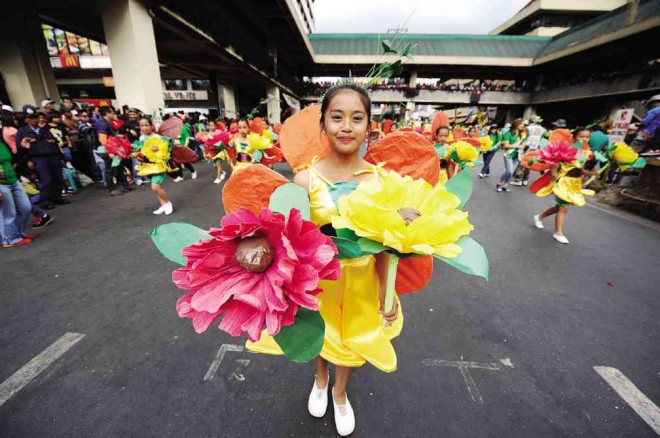
BAGUIO pupils, dressed in bright dresses, dance along downtown Baguio streets during the opening parade of this year’s Baguio Flower Festival on Sunday. This is the 20th staging of the event designed to draw back tourists to Baguio, which rebuilt from the devastation of the 1990 Luzon earthquake.
BAGUIO CITY – Marching bands and smiling children wearing bright-colored costumes took over downtown Baguio streets again on Feb. 1, announcing to residents and tourists that a chilly Sunday was the start of this year’s annual Baguio Flower Festival or Panagbenga.
Weekend visitors, some from Nueva Ecija province while others from as far as Bicol region, gathered along the city’s sidewalks to watch the opening parade highlighted by street dances performed by pupils from 12 elementary schools. The city’s temperature had plunged to 11.2 degrees Celsius on Sunday.
The tourist-drawing event was developed to revive Baguio tourism in 1995, after the city rebuilt from the devastation of the 1990 Luzon earthquake.
This year’s parade featured children who wore flower-inspired costumes and carried flower-shaped parasols and other props. One school sent out children wearing fairy tale-inspired garments, while another school’s performers wore traditional Cordillera g-strings, but armed with giant flower petals made of recycled materials.
A few meters away, however, other residents stood patiently with their groceries, to wait for the parade to end and traffic flow to normalize.
The city government has been taxing its resources to fix the traffic flow for the monthlong festival, hoping to prevent the gridlock that spoiled the Christmas holidays.
Tourists endured inner city gridlocks on their way to Camp John Hay, the Mines View Park, and the suddenly popular Sitio Pungayan in Mt. Sto. Tomas during Christmas week, the New Year’s Day weekend, and again during the long Metro Manila holiday for the papal visit, said Supt. Evelio Degay, traffic division chief of the Baguio City police.
Traffic flow normalized at 11 a.m. on Sunday. At the end of the parade, city workers pulled out ropes and barriers, and garbage trucks collected trash, allowing motorists to drive through main streets.
The city government held a traffic summit on Jan. 20 where Mayor Mauricio Domogan proposed enforcing one-way traffic at certain hours for vehicles using Kennon Road during the tourist season.
Each time tourists bring their vehicles to the city, they add to the 35,318 public and private vehicles that use Baguio’s busy streets, said Robert Pocais, Cordillera regional operations chief of the Land Transportation Office.
This means navigating roads designed initially for 20,000 people in 1909, said Brigida Ancheta, an engineer assigned to the city building and architects’ office. Vincent Cabreza with reports from Desiree Caluza, Inquirer Northern Luzon
RELATED STORIES